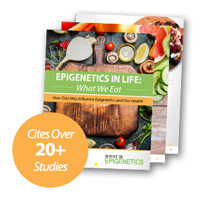
There is strong evidence that suggests certain environmental or lifestyle factors may lead to increased risk of developing chronic diseases. These factors such as diet, behavior, stress, exposure to pollutants, and physical activity have been known to cause epigenetic changes which may be passed down from one generation to the next. It is believed that a father’s exposure to environmental factors can play a role in an offspring’s epigenetic patterns and health.
Recent evidence suggests that sperm epigenetic modifications can survive reprogramming following fertilization and be inherited by the embryo. Three types of epigenetic modifications that can be paternally inherited are DNA methylation, histone modifications and noncoding RNAs (ncRNAs).
DNA methylation is the process by which methyl groups are added to cytosine or adenine and inhibit transcription. DNA methylation patterns are erased and reestablished during gametogenesis and embryogenesis. These two points provide susceptible windows for environmental exposures to alter methylation patterns. Changes in DNA methylation can induce abnormalities in chromatin structure and gene expression.

Studies have shown that certain DNA methylation marks can survive genome-wide reprogramming and be inherited. For example, paternal pre-diabetes has been demonstrated to increase the susceptibility of diabetes in an offspring due to altered sperm DNA methylation patterns. A father’s exposure to phthalates has been shown to impact epigenetic marks on sperm DNA and can have an impact on a couples’ ability to have children. Even stressed fathers might epigenetically pass on high blood sugar to their kids.
Disorders may also be caused by the failure of erasure during gametogenesis, as in the case of Angelman syndrome, a rare neuro-genetic disorder characterized by developmental delay, lack of speech, balance issues, and seizures. In certain individuals, the methylation marks at the SNURF-SNRPN locus is not erased resulting in Angelman syndrome with paternal origin.
Histone modifications describe histones that are subjected to posttranslational modifications, such as methylation, phosphorylation, acetylation, ubiquitylation, and sumoylation. The majority of promoters associated with embryonic development contain an activation mark, such as trimethyl H3K3 (H3K3me3), and a silencing mark, trimethyl H3K27 (H3K27me3), providing an additional mechanism where paternal DNA plays a role in the regulation of embryogenesis.
One study revealed that male mice fed a low-protein diet were observed to have lower levels of H3K27me3 at specific loci. Another study found that paternal exposure to sulforaphane could inhibit HDAC activity resulting in increased acetylation. These findings suggest that paternal environmental factors can cause changes in histone modifications and be passed down to offspring.
Noncoding RNAs are RNA fragments, such as miRNA, siRNA, piRNA and IncRNA, which regulate gene expression levels at the transcriptional and post-transcriptional level. During the sperm maturation process, sperm cells are able to uptake novel miRNAs. For example, miR-34c, which is the most abundant sperm miRNA, has been shown to be necessary for early embryonic cell division. This provides a mechanism in which ncRNA may be inherited and can have an impact on embryonic development and offspring health. miRNA-375 which is associated with paternal stress has been linked to depressive behavior and compromised glucose metabolism in offspring.
Another study found that obese males exhibited abnormal expression of several miRNAs in their sperm. The miRNAs are believed to pass on insulin resistance to offspring, which can cause diabetes. These results demonstrate the potential impact the ncRNA can have on embryonic development and induced epigenetic inheritance.
It is evident that paternal environmental exposure can alter the epigenetic profiles of sperm cells and subsequently inherited by offspring. Further studies are necessary in order to understand and identify environmentally induced epigenetic markers that are inherited across generation and increase the risk for susceptibility to diseases. A better understanding of the underlying mechanism that allows epigenetic markers to survive erasure and reprogramming can be used to develop diagnostic and therapeutic treatments for these diseases.
Source: Zhao et al., Environmentally induced paternal epigenetic inheritance and its effects on offspring health. Reprod Dev Med. 2017. 1, p89-99.



